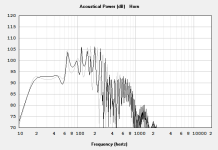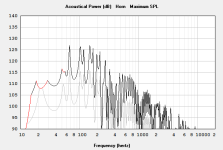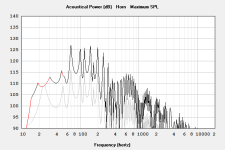Hello,
Would a TH expert be so kind as to model a TH tuned around 18hz (or lower if possible)? Curious to see what this driver can output in the very LF. Crossover will be @ 80hz. I have zero experience with hornresp.
I have a sph390tc and a second one coming soon. I would like to build 2 tall subs with a small footprint that will function in a home theatre.
My current sub is a large vented one that does the job pretty good. It's time to change things up and take advantage of the low distortion and high spl that comes with a TH.
A nad 214 (2*80W @ 8 ohms, 2*120W @ 4 ohms) with power cap mod will power the setup. Reviews have shown that the specs are conservative which leaves a little headroon. A minidsp will do some HP protection and in time REW.
Much appreciated!
Would a TH expert be so kind as to model a TH tuned around 18hz (or lower if possible)? Curious to see what this driver can output in the very LF. Crossover will be @ 80hz. I have zero experience with hornresp.
I have a sph390tc and a second one coming soon. I would like to build 2 tall subs with a small footprint that will function in a home theatre.
My current sub is a large vented one that does the job pretty good. It's time to change things up and take advantage of the low distortion and high spl that comes with a TH.
A nad 214 (2*80W @ 8 ohms, 2*120W @ 4 ohms) with power cap mod will power the setup. Reviews have shown that the specs are conservative which leaves a little headroon. A minidsp will do some HP protection and in time REW.
Much appreciated!
Last edited:
A TH for 19 Hz is going to be large, very large. For a 40cm woofer even larger. What size is you room?
Greets!
Note that as Fb is lowered, so goes its HF upper limit since a 'pure' TH is basically a 2.5 octave device max, so tuned to ~16 Hz it's limited to ~60 Hz, ergo 80 Hz puts it a little into its highly resonant BW, so may need some damping in the TH to smooth out if your electronics can't do it satisfactorily.
Also, even with a modest 110 dB/m/50 W/2pi peak it's going to be ~650 L net due to the driver's high Vas.
Note that as Fb is lowered, so goes its HF upper limit since a 'pure' TH is basically a 2.5 octave device max, so tuned to ~16 Hz it's limited to ~60 Hz, ergo 80 Hz puts it a little into its highly resonant BW, so may need some damping in the TH to smooth out if your electronics can't do it satisfactorily.
Also, even with a modest 110 dB/m/50 W/2pi peak it's going to be ~650 L net due to the driver's high Vas.
Last edited:
Room is about 260cm heigh, 500cm wide and 800cm lenght (roughly because it connects to a dining area)A TH for 19 Hz is going to be large, very large. For a 40cm woofer even larger. What size is you room?
Then 60 hz it is. Or 70 hz with minor damping. Was thinking of a sub that is about 250 cm tall and a footprint of ~60 cm wide and 50 cm deep depending on the modeling. That's about 650 liters.Greets!
Note that as Fb is lowered, so goes its HF upper limit since a 'pure' TH is basically a 2.5 octave device max, so tuned to ~16 Hz it's limited to ~60 Hz, ergo 80 Hz puts it a little into its highly resonant BW, so may need some damping in the TH to smooth out if your electronics can't do it satisfactorily.
Also, even with a modest 110 dB/m/50 W/2pi peak it's going to be ~650 L net due to the driver's high Vas.
OK, HR sim attached. You'll have to use Brian's folding designer to see how close you can get to your dims.
edit: Added a DTS sim that extends the HF a little bit by ~filling in a basic TH's 3rd harmonic dip by offsetting the driver's location. Overlay: TH/dark, DTS/light trace
edit: Added a DTS sim that extends the HF a little bit by ~filling in a basic TH's 3rd harmonic dip by offsetting the driver's location. Overlay: TH/dark, DTS/light trace
Attachments
Last edited:
The light trace is acceptable. Room acoustics will change things regardless so I need to do some eq anyway.OK, HR sim attached. You'll have to use Brian's folding designer to see how close you can get to your dims.
edit: Added a DTS sim that extends the HF a little bit by ~filling in a basic TH's 3rd harmonic dip by offsetting the driver's location. Overlay: TH/dark, DTS/light trace
Could you plot max spl at xmax for me please? Both graphs would be nice.
@GM
I renamed your .txt to .dat but can not open them. HR displays: The existing Hornresp data file is about to be changed to a new format. The conversion may need a few seconds.
Then a donut turns and nothing happens. I have the HR version from the editors home page, downloaded a minute ago.
What am I doing wrong?
Thank you!
I renamed your .txt to .dat but can not open them. HR displays: The existing Hornresp data file is about to be changed to a new format. The conversion may need a few seconds.
Then a donut turns and nothing happens. I have the HR version from the editors home page, downloaded a minute ago.
What am I doing wrong?
Thank you!
As you can see you'll need some significant room/corner gain to boost the 1st two octaves (~16-64 Hz), i.e. basically its entire gain BW.The light trace is acceptable. Room acoustics will change things regardless so I need to do some eq anyway.
Could you plot max spl at xmax for me please? Both graphs would be nice.
Attachments
The max. SPL in the prefered range seems quite low for such a huge chassis. On the other hand, inside your room things look very different and you can not predict odd shaped, half open rooms. In my experience such rooms are always better than plain boxes. My livingroom for example can not be simmulated (by me) and has no audible modes at all, which is quite surprising (gable roof, highest point 5.3 meters, L-shape with two parallel legs). I use Audessey multEQ xt32 with two sub's under the main speakers and the correction shows nothing exotic. Anyway, the response is much lower than the two10" woofer should go.
So expect these TH speakers to rock your house like mad, if you are crazy enough to build them. Two of them make the bass and low frequency effects seem effortless, while one may be noticed working. So if you like one, you will love two. Be sure your main speaker can match them, as you have to cut quite low to suppress the peaks of the TH. You will need a DSP and some serious amp.
So expect these TH speakers to rock your house like mad, if you are crazy enough to build them. Two of them make the bass and low frequency effects seem effortless, while one may be noticed working. So if you like one, you will love two. Be sure your main speaker can match them, as you have to cut quite low to suppress the peaks of the TH. You will need a DSP and some serious amp.
OK, HR sim attached. You'll have to use Brian's folding designer to see how close you can get to your dims.
edit: Added a DTS sim that extends the HF a little bit by ~filling in a basic TH's 3rd harmonic dip by offsetting the driver's location. Overlay: TH/dark, DTS/light trace
Thank you!
Ok so it seems that at low spl there is a 3.5 dB dip around 55 hz and at max spl a 5 dB peak according to the dark graph. The light one (adjusteds driver position) shows in my opinion a really undesired response at max spl.
110 dB at 18 hz is acceptable for me. A second sub makes it only better with the right positioning. I'll stick with the first model and play around with room positioning and eq.
The max. SPL in the prefered range seems quite low for such a huge chassis. On the other hand, inside your room things look very different and you can not predict odd shaped, half open rooms. In my experience such rooms are always better than plain boxes. My livingroom for example can not be simmulated (by me) and has no audible modes at all, which is quite surprising (gable roof, highest point 5.3 meters, L-shape with two parallel legs). I use Audessey multEQ xt32 with two sub's under the main speakers and the correction shows nothing exotic. Anyway, the response is much lower than the two10" woofer should go.
So expect these TH speakers to rock your house like mad, if you are crazy enough to build them. Two of them make the bass and low frequency effects seem effortless, while one may be noticed working. So if you like one, you will love two. Be sure your main speaker can match them, as you have to cut quite low to suppress the peaks of the TH. You will need a DSP and some serious amp.
Probably because of a limited 7mm xmax. Yes I am that crazy haha. Once I've build a Fane 2*15" folded horn and used that as a daily driver for years. Currently a 290 L vented sub with a large footprint made out of 32 mm mdf shakes the doors and windows.
I have a denon avc-3800x that lets me adjust the hpf of all speakers starting at 40 hz. All speakers have 8" woofers so thats probably enough for playing from 60 hz with decent spl.
The TH's will be powered by a modified nad 214 and a minidsp. Subs only need 50 watts of input power according to GM so that leaves a headroom of 70 watts per channel at 4 ohm load.
Thank you for your info.
Yeah, from ~30 Hz-up you can use 100 W.Subs only need 50 watts of input power according to GM so that leaves a headroom of 70 watts per channel at 4 ohm load.
Oh I thougt that the light trace was the modified model. I've misread it. Why is the 4 watt response so ugly compared to the very first one you posted earlier? That one was flat minus the 55 hz dip.You're welcome!
Not sure I follow, so here's the TH @ 4 W, 50 W (dark trace).
The tapped Horn is not really what you think of when you say "horn". It does not have such a huge increase in SPL like a "real" horn in the useable range.
It is not a large construct that only needs a 4 Watt tube amp to fill a whole cinema. Some serious power is fine, in the best case higher than the chassis rms.
It is not a large construct that only needs a 4 Watt tube amp to fill a whole cinema. Some serious power is fine, in the best case higher than the chassis rms.
- Home
- Loudspeakers
- Subwoofers
- Model TH request for sph-390tc


